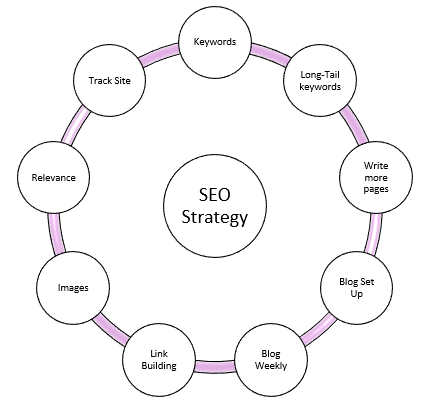How to Create an Effective SEO Strategy
 A SEO strategy is the process of planning, outlining and implementing steps to improve search engine rankings. It is a strategy webmasters use to gain more organic traffic. A SEO strategy can also be referred to as SEO approach or Search Engine Optimisation.
A SEO strategy is the process of planning, outlining and implementing steps to improve search engine rankings. It is a strategy webmasters use to gain more organic traffic. A SEO strategy can also be referred to as SEO approach or Search Engine Optimisation.
9 Steps for an Effective SEO Strategy

SEO Strategy Step 1 – Create a list of topics
Before jumping straight in to identifying keywords for your website. It is better to first identify topics that make sense and are relevant for your website. After you identify these topics, use keyword tools, and competitor analyses to generate about 10 to 15 short-terms phrases for each topic. The keywords selected should be relevant to what the users are searching for. Rank these keywords in order of search volume and relevance.
SEO Strategy Step 2 – List Long-Tail-Keywords
A simple process to help with this step is to create keyword clusters with the keywords identified in step one. For each main keyword identified, webmasters will identify related long-tail keywords. The idea of each cluster is to try to attract users with different interests. It is also a great way to try attract new users. In addition, search engines use long-tail keywords to connect more people with the information they are looking for.
SEO Strategy Step 3 – Build Content
Getting one page to rank for a number of different keywords is not always possible. With the right search engine optimization strategy, it may be a little easier.
From the topics identified in step one, webmasters can create a main page. For example, creating a page for the best sneakers. Then using long-tail keywords create supporting pages for the main page.
It is important to create pages that are relevant for your target audience. Images and links should also be added to pages.
SEO Strategy Step 4 – Create a Blog
Blogging is an easy and great way to rank for keywords and engage with users. Webmasters can also use blogs to elaborate on the website’s sub-topics.
What to include in blogs:
- Use long-tail keywords, but not more than four times.
- Link back to pages with the same topics or sub-topics.
- Link to blog posts from main topic pages or sub-topics.
SEO Strategy Step 5 – Blog Frequently
Ideally, you want to blog at least once a week Using long-tail keywords or supporting topics for main pages. Blog topics do not always need to belong to a cluster. Blogs are about writing for users and not search engines. So, you can write about topics that interests your audience. But at the same time, use relevant keywords.

SEO Strategy Step 6 – Link Building
Link building is the process of attracting in-bound links, also called, backlinks, from other websites. This is the primary off-page SEO tactic. Link-building plays an important role in how search engines rank websites. The more authority the referring website has, the bigger the impact will be on the ranking of your website. Sharing links on social media is also a form of link building.
SEO Strategy Step 7 – Compress Images
Compressing images may seem unimportant to some people, but has a vital function. Images are visual assets which help retain visitors’ attention. However, they are a form of computer files and take up space. This is why it is important to compress images before uploading. Compressing images also help with page speed.
SEO Strategy Step 8 – Stay Relevant & Current
The digital world is forever evolving. It is important to stay up to date with the latest trends and searches. Read articles and resources to find out what is happening in the world of seo. Resources will also help stay up to date with the latest Google algorithm changes.
SEO Strategy Step 9 – Measure Your Content’s Success
SEO can take a lot of time and effort. It is important to track what works and what doesn’t. There are a number of metrics and tools you can use daily, weekly, and monthly to track the success. One of the suggested tools is SEMrush as it allows you to track overall traffic, and the pages ranking for long-tail keywords.
But… A SEO Approach Doesn’t Stop There
We also need to build a process to optimize old pages to fit in with new algorithm changes, user intent and keywords.
- On a monthly basis, make time to update old blogs, and content with new information and keywords. You can also update alt tags, and add any other optimizations that wasn’t already done, like adding schemas.
- Look to see what content pages are ranking and the keywords they are ranking for. Use this information to adjust headings, and text to try and improve rankings.
- If the content is completely out of date, use the time to create fresh content. You can add new sections, revise existing copy, and update stats.
Related Articles
6 Steps for Effective Keyword Strategy


